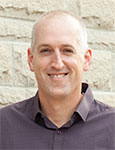Paul J. Ragogna

Contact Information
Title: Professor and Associate Dean of Science (Research)
Office: Rm 2024 B&GS,
Labs: 2004, 2006, 2008 B&GS
Phone (Office): N/A
Phone (Lab): ext 80049
E-mail: pragogna@uwo.ca
Inorganic Teaching Division
Synthesis, Catalysis and Molecular Materials
Synthetic main group small and macromolecular chemistry; UV curable coatings; Surface Science; Atomic (molecular) Layer Deposition
Education
Ph.D., Dalhousie University, 2004; B.Sc. (Honours), Brock University , 2000
AWARDS
- Florence Bucke Award (2018)
- Faculty of Science Distinguished Professor (2017)
- Strem Award for Pure/Applied Inorganic Chemistry (2014)
- University Faculty Scholar (2012)
- John Charles Polanyi Prize (2005)
RESEARCH
Work in the Ragogna Group is centred on the chemistry of the main group, p-block elements and usually feature the element phosphorus (P). We aim to discover unusual structure and bonding in small molecule architectures that then extend to unprecedented reactivity. Members of the group have a particular focus on P-H bond addition chemistry to element-element multiple bonds (e.g. C=C; C=N) and leverage these reactions to prepare novel linear and crosslinked macromolecular materials with properties to address real world problems. We translate our results to the modification of surfaces to impose them with anti-ice, antimicrobial, superhydrophobic or oxygen scavenging properties. After we develop solution phase, bulk scale syntheses for our functional materials we then endeavour to establish gas phase process so that the same materials can be deposited as thin films, 10-100 nm in thickness.
To accomplish these goals, we have a vibrant, diverse ecosystem of Postdoctoral, PhD, MSc and BSc researchers who work together with our expert technical staff in Western’s core analytical and tooling facilities across campus. Collaborative relationships with other research groups and regular interactions with private sector partners is a common part of our laboratory environment that provides breadth and diversity to research experiences. The team has many opportunities for tackling relevant ‘real world’ problems by dovetailing their activities with scientists working outside the university setting.
TEACHING
- Chem 1301 – Discovering Chemical Structure
- Chem 2271 – Structure and Bonding in Inorganic Chemistry
- Chem 2281 – Inorganic Chemistry of the Main Group Elements
- Chem 3371 – Transition Metal Chemistry
- Chem 4491 – Chemical Research Discovery and Scientific Communication
SELECTED PUBLICATIONS
- J.T. Lomax, E. Goodwin, P.G. Gordon, C. McGuiness, F. DeCampo, S.T. Barry*, P.J. Ragogna*. “Plasma-Enhanced Molecular Layer Deposition of Phosphane-Ene Polymer Films" Chem. Mater, 2023, 35, 4, 1579–1585.
- A.E.R. Watson, M.J. Grant, P.D. Boyle, P.J. Ragogna*, J.B. Gilroy*. “Heterocyclic Phosphenium Cations and Their Divergent Coordination Chemistry" Inorg. Chem., 2022, 61, 18719-18728.
- J.-W. Lamberink, P.D. Boyle, J.B. Gilroy, J.J. Noël, J.M. Blacquiere*, P.J. Ragogna*. “Reactivity of Primary Phosphines and Primary Phosphine Sulfides toward Imines" Chem. Eur. J., 2022, 52, e202201565.
- V.A. Béland, Z. Wang, T.K. Sham, P.J. Ragogna*. “Polymer Networks Functionalized with Low-Valent Phosphorus Cations" J. Polym. Sci., 2022, 60, 2508-2517.
- V.A. Béland, P.J. Ragogna*. “Metallized phosphane-ene polymer networks as precursors for ceramics with excellent shape retention” ACS Appl. Mater. Interfaces, 2020, 12, 27640-27650.

